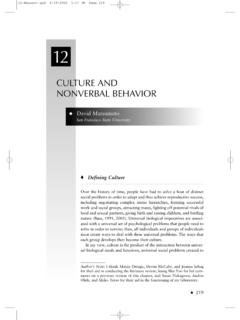Transcription of Childbirth and Culture Providing Services to Latin ...
1 Childbirth and Culture Providing Services to Latin American Families in the United States By Emily Wehby Childbirth , a universal biological event, occurs in all cultures and therefore may seem independent of any specific cultural influences. Culturally based beliefs and values, however, influence women's experiences of Childbirth and determine the practices a society believes appropriate for Providing care for pregnant and postpartum women. Since views and beliefs about the events surrounding Childbirth pregnancy, labor and delivery, and infant care vary by Culture , health care providers can increase their effectiveness by taking into account the home Culture of the new parents. An increasing number of children born in the United States are born to parents from Mexico and other Latin American cultures. Although a wide variety of diverse cultures often fall under the umbrella term Latin American, researchers have identified characteristics shared by many Latin American cultures.
2 Field research carried out in specific communities in Oaxaca, Yucat n, Texas, and Guatemala illustrate some of the beliefs and traditions surrounding Childbirth within these populations. Knowledge of such beliefs can help health care workers in the United States communicate more effectively with their immigrant patients. Childbirth as Culturally Based The research compiled in the collection Childbirth and Authoritative Knowledge highlights the role of cultural influence on women's Childbirth experiences. The editors Davis-Floyd and Sargent point out that birth is almost never simply a biological act; on the contrary .. birth is everywhere socially marked and shaped (2). Cultural views about women, women's bodies, and reproduction lead to a wide variation in the kinds of care pregnant women receive. Polynesian Culture , for example, values women's bodies and confers high status on pregnant women. Pregnant women are treated with great consideration and benefit from the attention of respected midwives.
3 In contrast, in Bangladesh and rural north India menstruation and birth are regarded as disgusting and intensely polluting and women are reluctant to assist other women in Childbirth , since if they do they will also be tainted by the pollution of birth (Davis-Floyd and Sargent 4). The extent to which a Culture embraces technology also affects the dominant views on Childbirth . A Culture that highly values technology, such as the United States, tends to view the process of Childbirth as requiring a high level of medical intervention. As a Culture experiences growth and change, views towards Childbirth may change as well. In Japan, for example, the majority of births before the 1960's occurred at home, attended by a midwife. In recent years, most Japanese births have taken place in hospitals. Although traditional midwives may still be present, they defer to the authority of the obstetrician. (Fiedler 160). Differing views about healthy delivery can cause friction when a woman of one Culture is attended by a doctor or other health care provider from a different Culture .
4 Davis-Floyd and Sargent illustrate this in their discussion of birth Culture among the Maya: From an American point of view, the Maya women encourage pushing much too early in labor, often resulting in a swollen cervix and a more painful and difficult labor than a Maya point of view, the medical practitioners in the clinics would be seen to be acting inappropriately when they forbid women to be accompanied by other women for support - a primary criterion of indigenous Maya birth - as well as when they demand unnecessary genital exposure, which the Maya perceive as shameful (3). The Growing Hispanic Population in the United States Various newspaper articles in recent years have pointed out the rapidly growing Hispanic population in the United States. A San Francisco Chronicle article of February 2003 reports that beginning in July, 2001, more than half of all California babies were Latino (Hendricks A17).
5 The population increase is due partly to immigration and partly to births to Latinas already residing in the United States, who tend to have a higher fertility rate than women of other cultural groups. Although immigrants enter the United States from many countries in Central and South America, the greatest number come from Mexico, El Salvador, and Guatemala (Neria). In a study on the effects of migration experience on Mexican women's fertility, Lindstrom points out that migration from Mexico to the constitutes one of the largest migration systems in the world (1342). Marketing researchers also reference the growing Hispanic population. Marketing News reports that the US Hispanic marketplace grows at a phenomenal pace .. it is expected to make up 1/4 of the population by 2050 (James 17). Diversity of Latin American Cultures Immigrants to the United States from Latin America come from many different countries, speak different languages, and have different reasons for moving to the United States.
6 In most Latin American countries, Spanish is the dominant or official language. A significant percentage of the population, however, consists of indigenous groups. Individuals who identify with these groups may speak Spanish in addition to their native language or may speak only an indigenous language. Even among Spanish-speaking groups, there is a great deal of cultural diversity. Latin Americans living in the United States also differ as to degree of acculturation and economic status. Those who have resided in the United States longer are more likely to have gained a greater degree of proficiency in English and learned strategies that allow them to negotiate the host Culture . Many Latin American women who give birth in the United States have recently immigrated to the country and may face multiple challenges, as they are often living in the United States without extended family, speak little or no English .. and typically work in minimum wage, low-skill level jobs that do not offer benefits such as health insurance or paid sick leave (Denman-Vitale and Murillo 51).
7 This is not the case, however, for all Latina mothers who give birth in the United States. Many women who cross the border from Mexico solely for the purpose of giving birth in the United States are wealthy professionals who want to give their children the opportunities available to citizens. To do so, Mexican women simply apply for visitors visas that permit border residents to travel inside a 25-mile zone in the United States for up to three days, give birth in a hospital, and then return home to Mexico with the newborn (Gorman B1). Most of these women are members of the upper class who can afford to prepay in cash for hospital Services . Health care providers will probably encounter less cultural misunderstandings among this population, as they are more likely to be familiar with medical facilities and procedures. Some Characteristics and Beliefs Shared by Many Latin American Cultures Although Latin America comprises diverse cultures, health care researchers identify some cultural characteristics and beliefs surrounding Childbirth that are common to most groups within Latin America.
8 Latin American cultures tend to place a high value on personal relationships, trust, respect, and the extended family. While patients in Culture may trust health care providers because of the authority of their title or the prestige of the institutions with which they are associated, Latin Americans value a personal connection to a particular health care worker and give confianza, or trust and confidence, slowly, as the personal relationship develops. Respect for a person's age, gender, or position of authority also plays an important role in Latin American Culture . Denman-Vitale and Murillo point out that respect for the health care provider may prevent some Latin American patients from asking questions or voicing disagreement with the provider (53). The importance of family relationships leads to a high level of family participation in health care decisions, especially by the head of the household. Denman-Vitale and Murillo also observe that mothers infant care practices were influenced by their grandmothers' beliefs (54).
9 The American Public Health Association publishes an online pamphlet entitled Understanding the Health Culture of Recent Immigrants to the United States: A Cross-Cultural Maternal Health Information Catalog. The section on Latin America includes beliefs and practices about pregnancy and Childbirth that are common to many Hispanic cultures. Pregnant women often attach a safety pin, or two pins in the form a cross, to the front of their underwear in order to protect the baby from developing a cleft lip or palate. This is especially important during an eclipse and comes from the Aztec belief that an eclipse occurred when a bite was taken out of the moon. This led to the fear that a bite would be taken out of the baby's mouth. Women also may avoid cutting their hair when pregnant in order to prevent cutting the baby's vision. In some Latin American cultures, a pregnant woman s cravings are considered very important. If a mother's cravings are not satisfied, the baby might be born with unpleasant personality traits or physical characteristics associated with the food.
10 For example, if the mother craves strawberries and does not eat them, the baby might have strawberry spots (Neria). Some cultures, including many in Latin America, adhere to a hot-cold theory of illness. Illnesses, foods, and medications are assigned to either a hot or cold category. Hot foods and medications should be used to treat cold illnesses, and cold foods and medications should be used to treat hot illnesses. For instance, hot chicken soup and herbal teas might be used to treat an illness considered cold while in Culture health care practitioners might recommend foods such as fruits and orange juice, considered cold, to treat the same cold illness. According to the American Public Health Association, however, categorization of hot and cold for illnesses, medications, and foods does not necessarily relate to the literal meaning of hot and cold (Neria). Culture , tradition, and personal experiences lead to the classifications.






